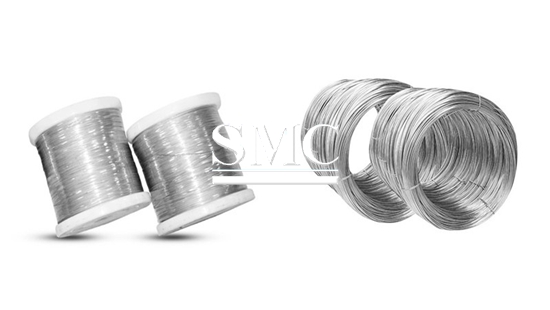Notice: Undefined index: sith_hide_share in /www/sites/alloy.wiki/index/wp-content/themes/likegoogle/single.php on line 32
Deprecated: get_settings is deprecated since version 2.1.0! Use get_option() instead. in /www/sites/alloy.wiki/index/wp-includes/functions.php on line 4862
1. Shape memory characteristics. Shape memory is that when a certain shape of the mother phase is cooled from above Af temperature to below Mf temperature to form martensite, the martensite is deformed below Mf temperature, and heated to below Af temperature, accompanied by reverse phase Change, the material will automatically recover its shape in the parent phase. In fact, the shape memory effect is a thermally induced phase transition process of nickel-titanium alloy.
2. Superelasticity The so-called superelasticity refers to the phenomenon that the sample produces a strain that is much larger than its elastic limit strain under the action of external force, and the strain can automatically recover when unloaded. That is, in the mother phase state, due to the effect of applied stress, stress-induced martensite transformation occurs, so the alloy exhibits different mechanical behavior than ordinary materials, its elastic limit is much larger than ordinary materials, and it no longer adheres to Hu Law of grams. Compared to shape memory properties, superelasticity has no thermal involvement. In a word, superelasticity means that the stress does not increase with the increase of strain within a certain deformation range. Superelasticity can be divided into two types: linear hyperelasticity and nonlinear hyperelasticity. The former stress-strain curve has a nearly linear relationship with stress. Non-linear superelasticity refers to the results of stress-induced martensitic transformation and its inverse phase transformation during loading and unloading in a certain temperature range above Af. Therefore, non-linear superelasticity is also called phase transition pseudoelasticity. The phase transition pseudo-elasticity of nickel-titanium alloy can reach about 8%. The superelasticity of nickel-titanium alloy can change with the change of heat treatment conditions. When the arch wire is heated above 400 degrees Celsius, the superelasticity begins to decrease.

3. Sensitivity to temperature changes in the oral cavity: The correction force of stainless steel wire and CoCr alloy tooth orthopedic wire is basically not affected by the temperature in the oral cavity. The correction force of super-elastic nickel-titanium alloy orthodontic wire changes with the change of oral temperature. When the amount of deformation is constant. As the temperature rises, the healing power increases. On the one hand, it can accelerate the movement of the teeth. This is because temperature changes in the mouth can stimulate blood flow in the blood stagnation site caused by the correction device, so that the repaired cells are fully nourished during the tooth movement. Maintain its vitality and normal function. On the other hand, orthodontists cannot accurately control or measure the corrective force in the oral environment.
4. Corrosion resistance: Some studies have shown that the corrosion resistance of nickel-titanium wires is similar to that of stainless steel wires.
5. Anti-toxicity: The special chemical composition of nickel-titanium shape memory alloy, which is an atomic alloy such as nickel-titanium, contains about 50% nickel, and nickel is known to have carcinogenic and pro-cancer effects. In general, the surface layer of titanium oxide acts as a barrier, which makes Ni-Ti alloys have good biocompatibility. The surface layer of TiXOy and TixNiOy can inhibit the release of Ni.
6. Gentle orthodontic force: The currently used dental orthopedic wires include austenitic stainless steel wires, cobalt-chromium-nickel alloy wires, nickel-chromium alloy wires, Australian alloy wires, gold alloy wires, and ß titanium alloy wires. About the load-displacement curves of these orthodontic correction wires under tensile test and three-point bending test conditions. The unloading curve platform of the nickel-titanium alloy is the lowest and the flattest, which indicates that it can provide the lasting and gentle healing power.
7. Good shock absorption characteristics: The greater the vibration caused by chewing and night molars to the archwire, the greater the damage to the root and periodontal tissue. According to the results of different bow wire attenuation experiments, it is found that the vibration amplitude of stainless steel wire is larger than that of super elastic nickel-titanium wire. The initial vibration amplitude of super elastic nickel-titanium bow wire is only half of that of stainless steel wire. Dental health is important, and traditional archwires, such as stainless steel, tend to increase root absorption.
Guest contributors are welcome at the Alloy Wiki.It is a weekly wiki and guide on alloy information and processing technology, while also about the vast array of opportunities that are present in manufacturing. Our team of writers consists of a Machining Material Supplier / Machinist / Tool and Die Maker, a Biomedical Engineer / Product Development Engineer, a Job Development Coordinator / Adjunct Professor, and a President and CEO of a manufacturing facility.
Link to this article:Special Properties of Nickel-Titanium Alloy
Reprint Statement: If there are no special instructions, all articles on this site are original. Please indicate the source for reprinting:Alloy Wiki,thanks!^^


